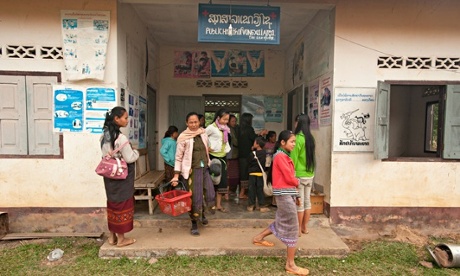
Spending on average $25 a woman annually on sexual and reproductive health services would drastically lower the number of women dying in pregnancy and childbirth, and the number of newborn deaths, says a report that calculates the cost and benefits of healthcare provision.
Although this amount equates to doubling current funding for reproductive health, the authors of the report – entitled Adding It Up: The Costs and Benefits of Investing in Sexual and Reproductive Health 2014 – say the long-term gains for women, society and the economy outstrip the costs.
The report, published on Thursday by the Guttmacher Institute and the UN population fund, the UNFPA, says $39.2bn (£20.9bn) a year is needed to provide an essential package of services to all women of reproductive age, typically between 15 and 49.
The package includes providing modern methods of contraception for all women who want them, offering the recommended levels of maternal and newborn healthcare, and effective care and support for women whose pregnancies end in miscarriage, stillbirth or abortion. It also includes HIV testing for pregnant women and antiretroviral treatment for those who are HIV-positive, as well as treatment for other sexually transmitted infections.
The payback would equate to: a 70% drop in unintended pregnancies annually, from 74m to 22m (which would in turn reduce the number of abortions and the number of deaths from unsafe abortions); a 67% drop in maternal deaths, from 290,000 to 96,000; a 77% drop in newborn deaths, from almost 3m to 660,000; and a 93% reduction in mother-to-child HIV transmissions.
According to the report, of the 125 million women who give birth each year, 54 million do not make the four antenatal visits recommended by the World Health Organisation. A total of 43 million women do not deliver in a health centre, 21 million need but do not receive care for complications in pregnancy and childbirth, and 33 million newborn babies who need care for complications do not receive it. In addition, more than 500,000 women who are HIV-positive do not receive treatment to prevent transmission of the virus to their child.
Ann Starrs, president and CEO of the Guttmacher Institute, said the report’s key message is that investing in sexual and reproductive healthcare has “huge benefits” for women, and also helps governments and policymakers to reduce their long-term health costs.
She argued that, despite gains in making pregnancy and childbirth safer over the past two decades, “these new findings make clear that universal access to sexual and reproductive health services must remain a global health priority requiring urgent attention”.
Starrs added: “The report also makes clear that this is an affordable goal that will have a dramatic impact in improving the lives of millions of women and families.”
The report, which gathers data from 149 countries, estimates that 225 million women who want to avoid pregnancy are not using an effective method of contraception.
Unmet need for contraception is higher among women from poorer households, those with limited education, and those living in rural areas, said the report. The regional variations are vast. Sub-Saharan Africa has the highest proportion of women who want to use contraception but are unable to access it – 58% – while south Asia has the largest absolute number. Across Asia, more than half of women of reproductive age want to avoid pregnancy, but 22% are either using no contraception or a traditional method.
Rizvina de Alwis, UNFPA’s Laos deputy representative, said lack of family planning is a major concern in the country. Contraceptive use has increased by 10% since 2000 but the number of women without access to any form of family planning remains high. “The unmet need for family planning is 20% in married women. We don’t even know what it is among unmarried women because that data isn’t available to us.”
De Alwis said the government began providing contraceptive implants to women two months ago and UNFPA staff were surprised by the response. “The uptake was so high, there were queues of women waiting. On the first day there were 800 women administered with the implants in government hospitals. Earlier, Laos only had three types of contraceptives – the condom, the pill and the injection. So it seems the demand is there and the need is great.”
The report estimates that every $1 spent on contraceptive services reduces the cost of pregnancy-related care by $1.47. If the need for contraception in developing countries is met, the cost of abortion care would drop from $794m to $225m.
Starrs said she hoped the report would feed into discussions on what should be included in the sustainable development goals, which will replace the millennium development goals after they expire next year. “We are in a relatively good situation right now,” she said. “The list of goals and targets does include one on sexual and reproductive health. But we want to make sure it stays in there, and be clear what that includes and covers.”

